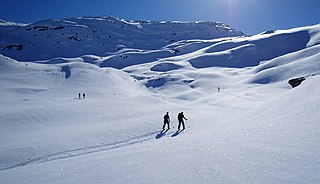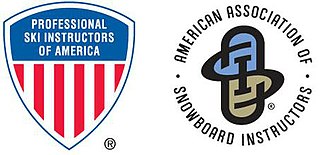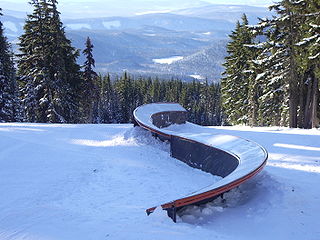History
The first steps for creating ISIA were actually undertaken by the main Alpine countries, in 1962, during the Interski Congress in Monte Bondone (Italy). A first congress on a visioning for an International Association for the Professional Ski Instructors, was held in 1964, under the leadership of the French Gaston Cathiard .
Eventually, ISIA was officially formed in 1970, when the first ISIA Constitution was written, and when Karl Gamma became the first President. The legal site of the Association is in Bern. The headquarters were in Belp, Switzerland, nearby Bern, until May 2018, then moved to Grainau, Germany, near Garmisch.
Karl Gamma is a Swiss alpine skier. He competed in the men's slalom at the 1948 Winter Olympics.

Grainau is a municipality in the district of Garmisch-Partenkirchen, in southern Bavaria, Germany. It is located at the foot of the Zugspitze mountain, the tallest mountain in Germany in the sub-mountain range of the Wetterstein Alps which is a branch off the main mountain range it is connected to, the Alps. Lake Eibsee in Grainau lies at the foot of the Zugspitze surrounded by forest.
There are currently 37 member nations representing the very best in ski instruction around the world.

Cross-country skiing is a form of skiing where skiers rely on their own locomotion to move across snow-covered terrain, rather than using ski lifts or other forms of assistance. Cross-country skiing is widely practiced as a sport and recreational activity; however, some still use it as a means of transportation. Variants of cross-country skiing are adapted to a range of terrain which spans unimproved, sometimes mountainous terrain to groomed courses that are specifically designed for the sport.

Skiing can be a means of transport, a recreational activity or a competitive winter sport in which the participant uses skis to glide on snow. Many types of competitive skiing events are recognized by the International Olympic Committee (IOC), and the International Ski Federation (FIS).

Snowboarding is a recreational activity and Winter Olympic and Paralympic sport that involves descending a snow-covered slope while standing on a snowboard attached to a rider's feet.

Alpine skiing, or downhill skiing, is the pastime of sliding down snow-covered slopes on skis with fixed-heel bindings, unlike other types of skiing, which use skis with free-heel bindings. Whether for recreation or for sport, it is typically practised at ski resorts, which provide such services as ski lifts, artificial snow making, snow grooming, restaurants, and ski patrol.
Freestyle skiing is a skiing discipline comprising aerials, moguls, cross, half-pipe and slopestyle as part of the Winter Olympics. It can consist of a skier performing aerial flips and spins, and can include skiers sliding rails and boxes on their skis. It is also commonly referred to as freeskiing, jibbing, as well as many other names around the world.

A ski school is an establishment that teaches skiing, typically in a ski resort. The modern version of the ski school was invented by the Austrian ski pioneer Hannes Schneider in the early 1920s when he formalized instruction methods and established these methods as teaching principles for all ski instructors at his school.

Ski patrols are organizations that provide medical, rescue, and hazard prevention services to the injured in ski area boundaries, or sometimes beyond into backcountry settings. Many have technical-medical certifications, such as Outdoor Emergency Care (OEC) provided by the National Ski Patrol (USA), that are specific to the winter-season environment and providing emergency medical services in remote locations. Many patrollers also hold EMS issued credentials, such as emergency medical technician or any other pre-hospital care certification. Due to the remote location and terrain, transportation is often limited to ski toboggan, snowmobile, or, for life-compromising injuries or extremely remote terrain, helicopter rescue. Depending on the ski area terrain, ski patrollers can be versed in a large variety of specialized rescues, such as avalanche search and rescue, outdoor emergency transportation, chairlift evacuation, and, in some cases, helicopter rescue techniques are taught. Patrols work to promote ski safety, enforce area policies, and help the injured within their jurisdiction. Ski patrollers also work to set up the mountain before it opens by conducting trail checks, providing avalanche control work, and setting up necessary equipment in preparation for the day. At the end of the day, they also conduct a sweep clearing the mountain for off-hours.
The system was developed by Hannes Schneider while working as an instructor in the Arlberg mountains in Austria. His methods were popularized in Europe in a series of films in the 1920s and 30s. It became popular in the United States after Schneider moved there in 1939, having been jailed during the Anschluss.

The Professional Ski Instructors of America andAmerican Association of Snowboard Instructors (PSIA-AASI) is the world’s largest nonprofit education association dedicated to promoting the sports of skiing and snowboarding through instruction. With more than 32,500 members instructing at 300 member ski and snowboard schools, PSIA-AASI establishes certification standards for snowsports instructors and develops education materials to be used as the core components of instructor training.

The Confédération Européenne de Volleyball or CEV is the continental governing body for the sports of volleyball, beach volleyball and snow volleyball in Europe. Its headquarters are located in Luxembourg, Luxembourg.

A carved turn is a skiing term, used to refer to a turning technique in which the ski shifts to one side or the other on its edges. When edged, the sidecut geometry causes the ski to bend into an arc, and the ski naturally follows this arc shape to produce a turning motion. The carve is very efficient and allows the skier to maintain their speed, unlike older techniques like the stem Christie and parallel turns based on stemming which can create significant drag.

The U.S. Ski Team, operated under the auspices of the United States Ski and Snowboard Association (USSA), develops and supports men's and women's athletes in the sports of alpine skiing, freestyle skiing, cross-country, ski jumping, and Nordic combined. Since 1974 the team and association have been headquartered in Park City, Utah.

Badger Pass Ski Area is a small ski area located within Yosemite National Park. Badger Pass is one of only three lift serviced ski areas operating in a US National Park. It is situated five miles (8 km) south-southeast of the Chinquapin intersection of Wawona Road with Glacier Point Road in the southern area of Yosemite National Park. Glacier Point Road provides the access to this ski area. During high snow level and/or ski season, Glacier Point road terminates at Badger Pass ski Resort. Under these conditions, the remainder of Glacier Point Road is used for cross-country skiing access to Glacier Point and other destinations in the high country.
The Canadian Ski Instructors' Alliance (CSIA), founded in 1938, is an association of more than twenty thousand professional skiers located across Canada. The CSIA's purposes are to ensure a nationwide ski teaching standard through the development of effective skiing techniques and teaching methods and promote the importance of ski safety. The organization grants four general levels of certification, as well as several module certifications, such as snow park instruction, mogul skiing, and super giant slalom skiing. Each successive level demonstrates competence in ski instruction, pedagogy, as well as individual ski performance. As such, the highest level (four) is difficult to attain, with only a handful of instructors holding that level within each region. Lately, the CSIA came up with a merit certification for ski instructors that were part of the organization for twenty-five or more consecutive years. The celebrated members are normally awarded a "25-year member" pin, as well as a certificate, recognizing their efforts in the field.
The Ski Club of Ireland owns and runs the largest artificial ski slope in Ireland. It is located in County Wicklow close to the village of Kilternan.

The following outline is provided as an overview of and topical guide to skiing:

Disabled Sports USA serves more than 60,000 disabled athletes annually, making it one of the largest national multi-sport, multi-disability organizations in the United States. Disabled Sports USA is a United States-based nonprofit 501(c)(3) organization founded in 1967 and based in Rockville, Maryland providing opportunities youth and adults with disabilities to develop independence, confidence and fitness through participation in disabled sports.

Cerro Castor is a ski resort on the southern slope of Mount Krund, 26 km from the city of Ushuaia, in the Argentine province of Tierra del Fuego. Its tracks can be used during several months because of the cold weather of the region. The standard season takes place between June and October, and it is, thanks to the geographic location, the longest among the main ski centers in Argentina. Cerro Castor is the southernmost ski resort in the world.
LW9 is a para-Alpine and para-Nordic standing skiing sport class, a classification defined by the International Paralympic Committee (IPC) for people with upper and lower limb function problems, and includes cerebral palsy skiers classified CP5, CP6 and CP7, along with people with hemiplegia or amputations. For international skiing competitions, classification is done through IPC Alpine Skiing or IPC Nordic Skiing. A national federation such as Alpine Canada handles classification for domestic competitions. This classification is separated into two subclasses including LW9.1 and LW9.2.

The sport of cross-country skiing encompasses a variety of formats for cross-country skiing races over courses of varying lengths according to rules sanctioned by the International Ski Federation and by various national organizations, such as the U.S. Ski and Snowboard Association (USSA) and Cross Country Ski Canada. International competitions include the FIS Nordic World Ski Championships, the FIS Cross-Country World Cup, and at the Winter Olympic Games. Such races occur over homologated, groomed courses designed to support classic (in-track) and freestyle events, where the skiers may employ skate skiing. It also encompasses cross-country ski marathon events, sanctioned by the Worldloppet Ski Federation, and cross-country ski orienteering events, sanctioned by the International Orienteering Federation. Related forms of competition are biathlon, where competitors race on cross-country skis and stop to shoot at targets with rifles, and paralympic cross-country skiing that allows athletes with disabilities to compete at cross-country skiing with adaptive equipment.














